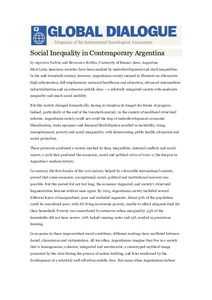Por favor, use este identificador para citar o enlazar este ítem:
https://repositorio.uca.edu.ar/handle/123456789/14375| Título: | Social inequality in contemporary Argentina | Autor: | Salvia, Agustín Rubio, María Berenice |
Palabras clave: | POBREZA; DESIGUALDAD SOCIAL; ESTRUCTURA SOCIAL; CRISIS ECONOMICA; CRISIS ECONOMICA; CRISIS POLITICA; DESEMPLEO | Fecha de publicación: | 2017 | Editorial: | International Sociological Association | Cita: | Salvia, A. y Rubio, B. Social inequality in contemporary Argentina [en línea]. Global Dialogue. Magazine of International Sociological Association. 2017, 7(4). Disponible en: https://repositorio.uca.edu.ar/handle/123456789/14375 | Resumen: | Most Latin American societies have been marked by underdevelopment and stark inequalities. In the mid-twentieth century, however, Argentinian society seemed to illustrate an alternative: high urbanization, full employment, universal healthcare and education, advanced intermediate industrialization and an extensive middle class – a relatively integrated society with moderate inequality and much social mobility. But this society changed dramatically, having to abandon its longed-for future of progress. Indeed, particularly at the end of the twentieth century, in the context of neoliberal structural reforms, Argentinian society could not avoid the trap of underdevelopment: economic liberalization, trade openness and financial flexibilization resulted in instability, rising unemployment, poverty and social marginality, with deteriorating public health, education and social protection. These processes produced a society marked by deep inequalities, internal conflicts and social unrest, a cycle that produced the economic, social and political crisis of 2001-2, the deepest in Argentina’s modern history. In contrast, the first decade of the 21st century, helped by a favorable international context, proved that some economic, occupational, social, political and institutional recovery was possible. But this period did not last long: the economy stagnated, and society’s structural fragmentation became evident once again. By 2015, Argentinian society included several different layers of marginalized, poor and excluded segments. About 30% of the population could be considered poor, with 6% living in extreme poverty, unable to afford adequate food for their household. Poverty was exacerbated by extensive urban marginality: 35% of the households did not have sewers, 20% lacked running water and 15% resided in precarious housing. In response to these impoverished social conditions, different readings have oscillated between denial, chauvinism and victimization. All too often, Argentinians imagine they live in a society that is homogeneous, cohesive, integrated and meritocratic, a stereotyped mythical image promoted by the state during the process of nation building, and later reinforced by the development of a relatively well-off urban middle class... | Cobertura Espacial: | Argentina | Cobertura Temporal: | Siglo XX Siglo XXI |
URI: | https://repositorio.uca.edu.ar/handle/123456789/14375 | ISSN: | 2519-8688 | Disciplina: | SOCIOLOGIA | Derechos: | Acceso abierto | Fuente: | Global Dialogue. Magazine of International Sociological Association. 2017, 7(4) |
| Aparece en las colecciones: | Colaboraciones en ediciones externas |
Ficheros en este ítem:
| Fichero | Descripción | Tamaño | Formato | |
|---|---|---|---|---|
| social-inequality-contemporary-argentina.pdf | 248,6 kB | Adobe PDF |  Visualizar/Abrir |
Visualizaciones de página(s)
88
comprobado en 27-abr-2024
Descarga(s)
280
comprobado en 27-abr-2024
Google ScholarTM
Ver en Google Scholar
Este ítem está sujeto a una Licencia Creative Commons

